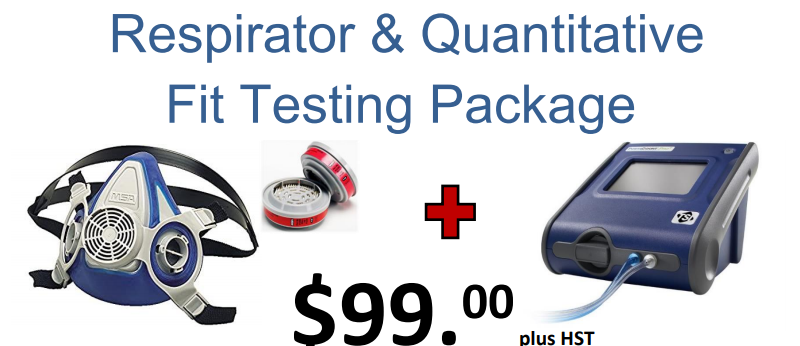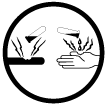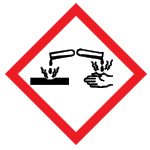In 2015, Canada rolled out a country-wide update to the look and meaning of the symbols in the WHMIS system.
Standing for “Workplace Hazardous Materials Information System,” WHMIS is a comprehensive system for providing health and safety information on hazardous products intended for use, handling, or storage in Canadian workplaces.
Read on to see how the WHMIS symbols changed, and how to get yourself up to speed.
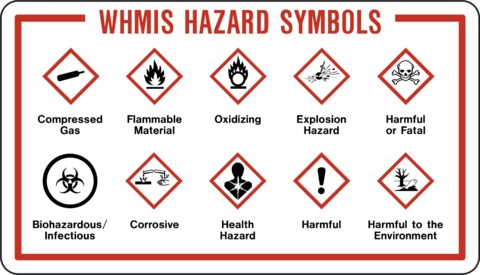
2015 WHMIS Symbols
2015 WHMIS Symbols Changes
In 2015, the Canadian Center for Occupational Health and Safety aligned the Workplace Hazardous Materials Information System (WHMIS) with the Globally Harmonized System of Classification and Labelling of Chemicals (GHS), resulting in significant updates with respect to WHMIS symbols.
WHMIS 1988 (the original version) was phased out in December 2018.
WHMIS symbols are presented in the form of pictograms, defined as “graphic images that immediately show the user of a hazardous product what type of hazard is present.”
Most pictograms have a distinctive red border, and inside this border is a symbol that represents the potential hazard (e.g., fire, health hazard, corrosive, etc.).
The 2015 changes updated the look of the WHMIS symbols, replacing the old black and white circles with the red, pointed borders.
It also replaced a letter-based classification system with clear and concise descriptions of the hazards they entail.
To help keep all the changes straight, here’s a handy infographic courtesy of Workplace Alberta.
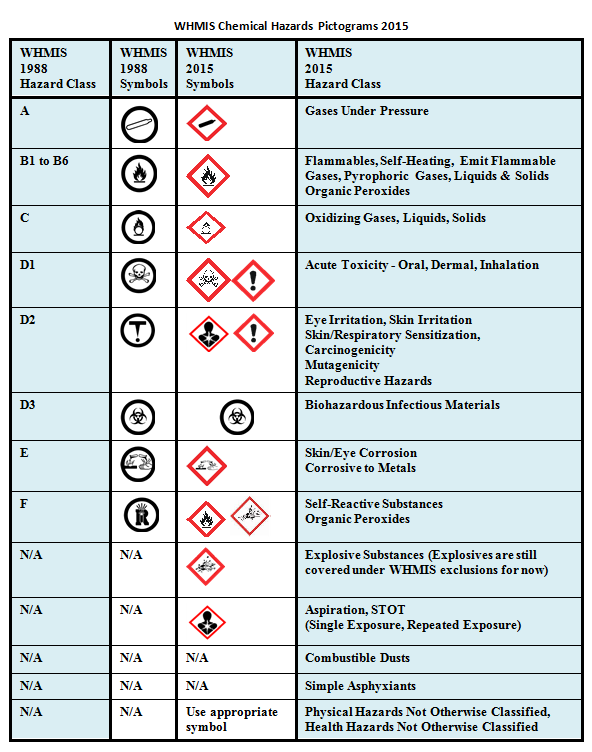
2015 WHMIS Symbols
Click here for a detailed breakdown of the 7 changes to the WHMIS symbols.
Who needs WHMIS training?
You will need WHMIS training if:
- You may be exposed to chemicals or a hazardous product during work activities (this includes normal use, maintenance, and emergencies) ✓
- You may be exposed to, use, store, handle, or dispose of hazardous products and materials ✓
- You supervise workers who may be exposed to, use, store, handle, or dispose of hazardous products and materials ✓
- You work in emergency response ✓
WHMIS training is mandatory for any workers who work with or who may be potentially exposed to hazardous products in the workplace.
Related:
WHMIS 1988 – Classification
WHMIS 2015 – Pictograms
Stay Safe at Work with Respirators that Fit Properly
If you work around hazardous chemicals and other materials and need to wear a respirator, ensure that your respirator fits properly. A respirator that doesn’t fit properly or is the wrong type, could mean that you are not properly protected.
ACUTE offers respirator and quantitative fit testing that can help you be sure that you have the maximum protection possible.
7 Changes to Canadian WHMIS Symbols
1. Gas Cylinder
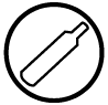
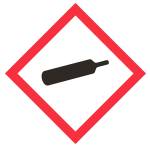
In 1988, the symbol on the left indicated “Class A – Compressed Gas” and was used to describe any material that is normally a gas that is placed under pressure or chilled, and contained by a cylinder
The symbol has now been updated and is accompanied by a clear “Gasses Under Pressure” description, which includes compressed gas, liquefied gas, refrigerated liquefied gas, and dissolved gas.
2. Flame Over Circle

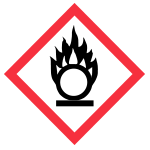
The symbol that used to indicate “Class B – Oxidizing Materials” is now used to point to the presence of oxidizing liquids, gases, and solids.
All of these do not usually burn themselves, but they will either help the fire by providing more oxygen, or they may cause materials that do not normally burn to catch fire (spontaneous combustion).
3. Flame

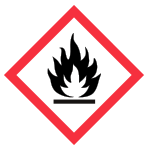
The WHMIS symbol for flammable and combustible materials has remained fairly similar and has been simplified to point out all fire hazards including:
- Flammable gases, aerosols, liquids, and solids
- Pyrophoric liquids, solids, and gases
- Self-heating substances and mixtures
- Substances and mixtures which, in contact with water, emit flammable gases
- Self-reactive substances and mixtures
- Organic peroxides
4. Poisonous Materials

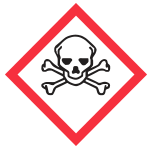

The old skull and crossbones symbol was used to point out materials that are very poisonous and considered to bring immediate danger to life and health. At the same time, the exclamation point was used for materials whose effects are not always quick, but if immediate they are only temporary.
In 2015, they were combined to indicate the following:
- Acute toxicity – Oral, dermal, inhalation
- Skin corrosion/irritation – Skin irritation
- Serious eye damage/eye irritation – Eye irritation
- Respiratory or skin sensitization – Skin sensitizer
- Specific target organ toxicity – Single exposure
This is to make the employee aware of all the dangers and to treat all hazardous materials as equally dangerous, regardless of their effects.
5. Poisonous Materials (continued)
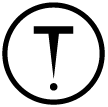


Additionally, a torso symbol was added to the updated exclamation point to indicate general health hazards such as:
- Respiratory or skin sensitization
- Germ cell mutagenicity
- Carcinogenicity
- Reproductive toxicity
- Specific target organ toxicity – Single exposure
- Specific target organ toxicity – Repeated exposure
- Aspiration hazard
7. Reactive Substances

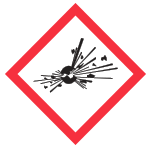

The old dangerously reactive material symbol has been replaced with an exploding bomb pictogram, now used for the following:
- Self-reactive substances and mixtures
- Organic peroxides
It’s also combined with the flame pictogram to further highlight the dangers.
Training With ACUTE
With over 100 years of combined experience, you can be sure to receive quality, hands-on training from knowledgeable and experienced staff. Here are some of the differences when training with ACUTE:
- Open Door Instructor-Student Partnership – ACUTE’s training services emphasize client participation. Our staff
 want to build a relationship with clients and serve as a touchstone for advice anytime moving forward.
want to build a relationship with clients and serve as a touchstone for advice anytime moving forward. - Serving Your Team and Industry – With a vast array of clients in the manufacturing, construction, health, academic, and government sectors, ACUTE brings the best safety practices from across the spectrum to your workplace.
- 100 Years Combined Experience – ACUTE provides comprehensive health and safety training, on-site safety services, and consulting services. With over 100 years of combined experience, our company staff offer more than theoretical or abstract ideas. ACUTE offers solutions.
- Track Record of Success – ACUTE is rated 4.9/5 stars on Google reviews, demonstrating a commitment to our clients, quality, and passion for training.
What Our Customers Are Saying…
“ACUTE’s trainers have a passion for the material and care about their clients.”
– Rob, Tank Manufacturing Company
ACUTE is located in Waterloo, Ontario, and services customers from the cities such as Toronto, Mississauga, Brampton, Hamilton, Milton, Kitchener, London, and Guelph, as well as other cities from across Ontario.
Sources:
https://www.workplacesafetynorth.ca/print/2268
http://www.ccohs.ca/oshanswers/chemicals/whmis_ghs/general.html

